Want to Unplug — But Not Disappear?
Here’s how to start a digital detox without ditching your social life — and why your brain will thank you.
You know that constant itch to check your phone? Or the mindless scroll that somehow lasts 47 minutes? If you’ve been craving less screen time and more you time, you’re not alone. But the biggest fear about unplugging is: Will I feel left out?
The good news is, a digital detox doesn’t have to be extreme — and it absolutely doesn’t mean social exile. In fact, when done right, you’ll feel more present and connected than ever.

What Is a Digital Detox (Really)?
A digital detox is intentional time away from screens and connected devices — think smartphones, social media, laptops, and sometimes even TV or gaming. The goal is to reduce digital overwhelm, reclaim focus, and reconnect with the real world.
But it’s not all or nothing. Detoxing digitally is more like decluttering — you choose what stays and what goes.
Why It’s Worth Trying
🧠 Better Focus and Less Anxiety
Studies from the Journal of Behavioral Addictions show that too much screen time disrupts sleep, shortens attention spans, and raises stress levels (Lin et al., 2022).
💤 Improved Sleep
Blue light messes with melatonin, making it harder to fall and stay asleep (Harvard Health, 2023). A detox — especially at night — can work wonders for rest.
🧘 More Mindfulness and Real Connection
Even 24 hours without social media can increase awareness, productivity, and real-world joy, according to Psychology Today (2023).
How to Get Started with a Digital Detox (Without Going Off the Grid)
1. Define Your Why
Before you unplug, ask yourself:
- What do I want more of? (Focus, calm, real connection?)
- What am I escaping from? (Overwhelm, comparison, burnout?)
Clarity helps you stay committed and set clear limits.
2. Start Small — Try a “Soft Detox”
You don’t have to ghost the internet. Start with:
- No phone during meals
- 1 screen-free hour before bed
- Turning off notifications (especially social ones)
Even reducing usage by 20% can bring results.
3. Tell People You’re Detoxing
FOMO often comes from not communicating. Let friends, coworkers, and family know:
“I’m unplugging a bit to reset. If you need me, just text or call.”
This sets boundaries and eases anxiety about missing out.
4. Replace Screen Time With IRL Joy
Don’t just subtract — substitute. Try:
- Journaling or sketching
- Reading a real book
- Walking without headphones
- Trying a new recipe or puzzle
- Visiting a friend (like, in person)
5. Schedule “Check-In” Windows
Instead of banning screens, use them with intention:
- 2 check-in slots/day for messages and social media
- Max 20 minutes per session
- Set a timer or use app limiters like Freedom or Moment
This keeps you connected — without the black hole scroll.
6. Create Tech-Free Zones
Designate areas like:
- The dinner table
- Your bed
- Your workout space
📵 Out of sight = out of mind.
7. Use “Grayscale Mode”
Want to make your phone less addictive instantly? Set your screen to grayscale. The dull tones make apps way less appealing.
Tips to Avoid Feeling Left Out
- 📅 Plan IRL hangouts: Replace screen time with actual face time.
- 📞 Make a call instead of DMing: A 5-minute chat is more meaningful.
- 💬 Join a digital detox challenge: Use accountability and community to stay motivated.
- ✨ Remind yourself: you’re not missing out, you’re checking in.
Real Voices, Real Results
“I thought I’d feel out of touch, but my anxiety dropped by half in three days. I was finally with myself again.”
— Jenna, content strategist
“I do a 24-hour detox every weekend. Now it’s something I look forward to.”
— Marcus, web developer
Final Thoughts: Disconnect to Reconnect
Starting a digital detox doesn’t mean disappearing from the world — it means reentering it more fully. You don’t have to delete your apps or abandon your phone forever. Just carve out moments of intentional disconnection and see what comes back to life.
Even 15 screen-free minutes a day can shift your mindset.
References
- Lin, L. Y., et al. (2022). Effects of smartphone addiction on sleep and attention span. Journal of Behavioral Addictions. Available at: https://akjournals.com/behavioraladdictions
- Harvard Health Publishing (2023). Blue Light and Sleep Disruption. Available at: https://www.health.harvard.edu/staying-healthy/blue-light-sleep
- Psychology Today (2023). Digital Detox and Mental Health Benefits. Available at: https://www.psychologytoday.com/us/digital-detox-research









